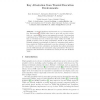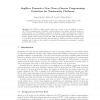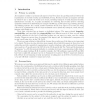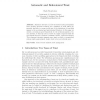TRUST
2010
Springer
14 years 1 months ago
2010
Springer
Abstract. Credential platforms implemented on top of Trusted Execution Environments3 (TrEEs) allow users to store and use their credentials, e.g., cryptographic keys or user passwo...
TRUST
2010
Springer
14 years 1 months ago
2010
Springer
We analyze empirical data of Germany’s largest online social lending platform Smava.de to exemplarily study the contribution of unstructured, ambiguous, or unverified informatio...
TRUST
2010
Springer
14 years 1 months ago
2010
Springer
The TPM is a fairly passive entity. As a result, it can be difficult to involve the TPM in measurements of software trustworthiness beyond simple load-time hashing of static progra...
TRUST
2010
Springer
14 years 1 months ago
2010
Springer
Physical Uncloneable Functions (PUF) are systems whose physical behavior to different inputs can be measured reliably, yet cannot be cloned in a physical replica. Existing designs ...
TRUST
2010
Springer
14 years 1 months ago
2010
Springer
TRUST
2010
Springer
14 years 7 months ago
2010
Springer
TRUST
2010
Springer
14 years 8 months ago
2010
Springer
TRUST
2010
Springer
14 years 8 months ago
2010
Springer
Academic discourse on trust is fractured along disciplinary lines. Security theorists routinely use a definition of trust which, apparently, has little in common with any of the d...
TRUST
2010
Springer
14 years 8 months ago
2010
Springer
Secure outsourcing of computation to an untrusted (cloud) service provider is becoming more and more important. Pure cryptographic solutions based on fully homomorphic and verifia...
TRUST
2010
Springer
14 years 8 months ago
2010
Springer
Abstract. Recent research demonstrates that adversaries can inject malicious code into a peripheral’s firmware during a firmware update, which can result in password leakage or...





